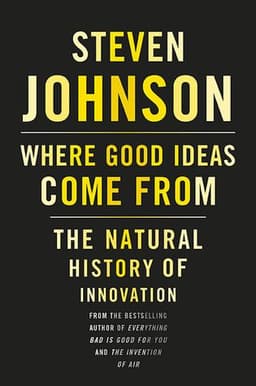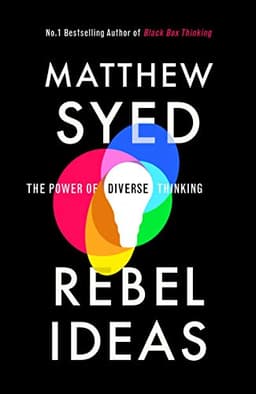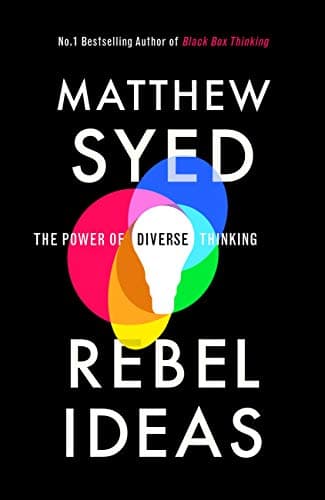
Where Good Ideas Come From Book Summary
The Natural History of Innovation
Book by Steven Johnson
Summary
Steven Johnson argues that breakthrough innovations arise from connected environments that enable the serendipitous collision of slow hunches, happy accidents, and novel combinations of existing ideas, rather than isolated eureka moments of lone genius.
Sign in to rate
Average Rating: 1
Darwin's Paradox: How Coral Reefs Thrive in Nutrient-Poor Waters
Charles Darwin was puzzled by how coral reefs, teeming with diverse life, could thrive in the nutrient-poor waters of the tropics. He realized the coral polyps themselves engineer the ecosystem, building calcium carbonate skeletons that provide habitat for millions of other species. Coral reefs demonstrate how certain environments enhance innovation by connecting ideas and making novel combinations possible.
Section: 1, Chapter: 1
Superlinear Scaling: Why Cities And The Web Generate More Innovation
Research has found that cities and the Web demonstrate "superlinear scaling" in terms of innovation and creativity. As cities get bigger, the rate of innovation per capita increases, so a city of 5 million produces almost 3 times more innovation per resident than a town of 100,000. Similarly, the Web has explored the adjacent possible of its medium far faster than other communications technologies. The density of connections in these environments nurtures innovative ideas.
Section: 1, Chapter: 1
The 10/10 Rule: Major Innovations Take A Decade To Develop
Looking at the history of innovation in the 20th century, a clear pattern emerges:
- It takes roughly a decade for a major new communications technology to go from initial development to mass adoption (the "10/10 rule")
- Examples: Radio, television, VCRs, PCs, cell phones, GPS
- In contrast, web-based innovations like YouTube can go from idea to mass adoption in 1-2 years by building on pre-existing platforms
The 10/10 rule demonstrates how the pace of innovation depends heavily on the surrounding environment and available building blocks
Section: 1, Chapter: 1
Thinking Outside the Box
"No One Can Think Outside The Box Because The Box Is All There Is"
"The trick to having good ideas is not to sit around in glorious isolation and try to think big thoughts. The trick is to get more parts on the table."
Section: 1, Chapter: 1
Adjacent Possible: How Environments Constrain And Enable Innovation
Good ideas are constrained by the "adjacent possible" - the realm of options and combinations available at any given moment based on the elements present. Just as evolution proceeds by taking available resources and cobbling them together in new ways, human innovation depends on building with the materials at hand:
- The Analytical Engine failed because Babbage didn't have the right "spare parts" (electronic, not mechanical computing)
- YouTube could not have succeeded in 1995 because the Web lacked key building blocks like Adobe Flash video and widespread broadband
- Truly innovative environments make it easier to find and combine the necessary spare parts to explore the adjacent possible
Section: 1, Chapter: 1
Embrace Serendipity By Cultivating Hunches And Hobbies
To have more innovative ideas, embrace serendipity and create opportunities for hunches to collide:
- Keep a "commonplace book" to write down ideas, quotes, and thoughts, and revisit it to allow ideas to recombine
- Take on multiple hobbies to have more "spare parts" for mental recombination
- Go for walks or take "reading sabbaticals" to trigger new associations Cultivating slow hunches over time, combined with serendipitous collisions, is the key to innovation, not sudden epiphanies.
Section: 1, Chapter: 1
Liquid Networks: The Ideal Environment For Sharing And Connecting Ideas
Innovative ideas start as networks of neurons connecting in the brain. The best environments for nurturing ideas are similarly dense liquid networks that allow partial ideas to connect and complete each other. Examples include:
- The first cities, which led to an explosion of innovative ideas and technologies compared to disconnected bands of hunter-gatherers
- Coffeehouse culture during the Enlightenment, where scientists and intellectuals could serendipitously share ideas
- The Krebs Cycle in cell metabolism, which evolved because of the densely connected liquid environment inside cells
- Research labs, where group meetings around shared problems lead to breakthrough solutions
Section: 1, Chapter: 2
"Those Shared Environments Often Take The Form Of A Real-World Public Space"
"Those Shared Environments Often Take The Form Of A Real-World Public Space"
"Participants flock to these spaces partly for the camaraderie of others who share their passions, and no doubt that support network increases the engagement and productivity of the group. But encouragement does not necessarily lead to creativity. Collisions do - the collisions that happen when different fields of expertise converge in some shared physical or intellectual space."
Section: 1, Chapter: 2
The Slow Hunch: Great Ideas Often Emerge Gradually Over Time
Many important ideas start as "slow hunches" - incomplete, vague notions that linger in the creator's mind, sometimes for years or decades, until another hunch or piece of information completes them. Examples include:
- Darwin's theory of natural selection, which emerged over 15 months of collecting evidence and considering arguments
- Tim Berners-Lee's idea for the World Wide Web, which began with childhood explorations and slowly evolved over a decade
Great ideas often need time to mature, as the creator encounters new information or hunches that can connect to the original insight. Breakthrough ideas are rarely sudden "eureka" moments.
Section: 1, Chapter: 3
Create A "Slow Hunch" Environment
To nurture slow hunches and make new connections between ideas:
- Keep a detailed commonplace book to collect ideas, quotes, questions, and thoughts
- Revisit your notebooks regularly to allow ideas to recombine and evolve
- Follow the example of great thinkers like Darwin, who constantly wrote down observations and reflections that shaped his theories over time
- Use digital tools like DEVONthink to create a searchable database of quotes, ideas, and notes with automatic linking between related concepts
By externalizing your memory and providing opportunities to encounter old ideas in new contexts, you increase the chances of serendipitous connections that lead to breakthroughs.
Section: 1, Chapter: 3
The History of Being Right
"The history of being spectacularly right has a shadow history lurking behind it: a much longer history of being spectacularly wrong, again and again. And not just wrong, but messy."
Section: 1, Chapter: 4
Serendipity: How Unlikely Collisions Between Ideas Drive Innovation
Serendipity - the occurrence of happy accidents that lead to new insights - is a key driver of innovation. Serendipitous discoveries often happen when:
- An idea that solves one problem unexpectedly provides the missing piece to another, unrelated challenge (e.g. Gutenberg borrowing the screw press from winemaking to enable the printing press)
- A "slow hunch" collides with new information encountered by chance (e.g. a stray spore leading to Alexander Fleming's discovery of penicillin)
- Mistakes or contamination lead to a novel result (e.g. vulcanized rubber, safety glass, pacemakers)
Innovative environments increase the likelihood of serendipity by encouraging novel connections between different fields and perspectives.
Section: 1, Chapter: 4
Error: How Being Wrong Forces Us To Explore New Possibilities
Making mistakes and being wrong are essential to innovation because they:
- Force us to question our assumptions and try new strategies
- Lead us to stumble across unexpected ideas that wouldn't have emerged otherwise
- Push us to explore the edges of the adjacent possible in ways that being right doesn't
Many world-changing innovations are the result of "happy accidents" that only happened because the innovator made a mistake or was spectacularly wrong about something else. Error is essential to evolution and innovation.
Section: 1, Chapter: 5
Embrace Negative Results
To be more innovative, don't just focus on reducing errors, but actively embrace them:
- Celebrate negative results that disprove your hypothesis, as they can open up new avenues for exploration
- Introduce "noise" into your data by considering deliberately wrong or opposing views, as studies show this leads to more creative insights
- Mimic biological evolution by introducing random "mutations" into your ideas and seeing what new combinations emerge
While too much error can be harmful, a certain amount of noise and chaos is essential for generating novel ideas and solutions. The most innovative environments find a balance between order and disorder.
Section: 1, Chapter: 5
Exaptation: How Innovations Find Unexpected Uses In New Contexts
Exaptation is the process by which a trait or innovation that originally evolved for one purpose gets hijacked for a completely different function. Examples include:
- Gutenberg borrowing the screw press from winemaking to create the printing press
- Microwave ovens emerging from radar technology developed during World War II
- Viagra originally being developed as a treatment for heart disease
Exaptation is a key driver of innovation, as it allows existing tools and ideas to be repurposed in novel ways to solve unrelated problems. The most innovative environments encourage the serendipitous connections that make exaptation possible.
Section: 1, Chapter: 6
Innovative Environments Thrive On Useful Mistakes
"Innovative environments thrive on useful mistakes, and suffer when the demands of quality control overwhelm them."
"Protecting ideas from copycats and competitors also protects them from other ideas that might improve them, might transform them from hints and hunches to true innovations."
Section: 1, Chapter: 6
Platforms: How Generative Environments Create A Foundation For Future Innovations
Platforms are environments or tools that provide a foundation for future innovations by creating new opportunities for combination and exaptation. Examples include:
- Coral reefs, which are built by small organisms but provide a habitat for thousands of other species to thrive
- The World Wide Web, which started as a simple hypertext system but has enabled countless other innovations to be built on top of it
- The iPhone and Android app stores, which allow third-party developers to create new tools and services on top of the basic smartphone platform
Platforms are often emergent, arising from the interactions of many independent agents rather than being planned in advance. They provide a fertile substrate for ongoing innovation.
Section: 1, Chapter: 7
Create Your Own "Coral Reef" By Building Networks
To create a generative platform for innovation in your own environment:
- Build open networks both inside and outside your organization, so that people with different skills and perspectives can share ideas and resources
- Default to sharing rather than protecting your ideas, so that others can build on them in unexpected ways
- Create opportunities for serendipitous connections and exaptations by exposing your work to diverse audiences
- Look for ways to reuse and recombine existing resources rather than always starting from scratch
By creating a dense web of connections and openly sharing your ideas and resources, you create a platform that enables ongoing innovation, like a coral reef enabling a thriving ecosystem.
Section: 1, Chapter: 7
The Fourth Quadrant: How Non-Market, Networked Innovation Drives Breakthroughs
Many important innovations emerge from the "fourth quadrant" - environments that are collaborative and non-market driven, like universities, open source communities, and amateur enthusiasts. The fourth quadrant is powerful because:
- It allows ideas to flow freely and recombine in novel ways, without concerns about intellectual property or market demands
- It attracts participants who are motivated by passion and curiosity rather than financial gain
- It creates serendipitous connections between different fields and perspectives
- It builds on open platforms and shared resources rather than proprietary technology
While market incentives can be powerful drivers of innovation, the fourth quadrant shows that other motivations and environments are equally important. The most innovative societies and organizations create a balance between market and non-market approaches.
Section: 1, Chapter: 8
Related Content


Range Book Summary
David Epstein
"Range" challenges the conventional wisdom that early specialization is the key to success. Instead, Epstein argues that in our increasingly complex and unpredictable world, it is those with broad experience and diverse skills who are best equipped to thrive.
"Range" challenges the conventional wisdom that early specialization is the key to success. Instead, Epstein argues that in our increasingly complex and unpredictable world, it is those with broad experience and diverse skills who are best equipped to thrive.
Personal Development
Learning
Psychology


Rebel Ideas Book Summary
Matthew Syed
Matthew Syed reveals the vital ingredient missing from our understanding of success: cognitive diversity. Rebel Ideas shows how bringing together different insights, perspectives and thinking styles turbocharges creativity, problem-solving and decision-making, to improve performance in today's complex world.
Matthew Syed reveals the vital ingredient missing from our understanding of success: cognitive diversity. Rebel Ideas shows how bringing together different insights, perspectives and thinking styles turbocharges creativity, problem-solving and decision-making, to improve performance in today's complex world.
Psychology
Innovation
Business
Leadership

